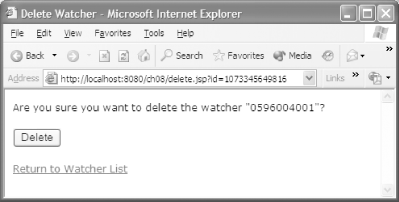8.2 Deleting a Watcher
Figure 8-4 shows the confirmation form presented when a user clicks the delete link.
Figure 8-4. Deleting a watcher

The code to present the deletion form is shown in Example 8-2. A small amount of validation is performed at the top of the page; otherwise, the JSP is mostly concerned with the user interface.
Example 8-2. Deleting a watcher JSP
<%@ page contentType="text/html; charset=iso-8859-1"
language="java" errorPage="" %>
<!DOCTYPE html PUBLIC "-//W3C//DTD XHTML 1.0 Transitional//EN"
"http://www.w3.org/TR/xhtml1/DTD/xhtml1-transitional.dtd">
<html xmlns="http://www.w3.org/1999/xhtml">
<%
boolean delete = false;
String productID = request.getParameter("productID");
if(request.getParameter("Delete") != null)
delete = true;
boolean deleted = false;
if(delete)
{
deleted =
com.cascadetg.ch04.Search.removeSearch(productID);
};
%>
<head>
<title>Chapter 4: Competitive Analysis</title>
<meta http-equiv="Content-Type"
content="text/html; charset=iso-8859-1" />
<link href="default.css"
rel="stylesheet" type="text/css" />
</head>
<body><%
if (delete)
{
if(deleted)
{
%>
<p>The item has been deleted.</p>
<% } else {
%>
<p>Item not found.</p>
<% }
} else{ %>
<p>Are you sure you want to delete the
item "<%= productID %>"?</p>
<form name="deleteForm"
method="post" action="delete.jsp">
<input type="hidden" name="productID"
value="<%= productID %>"/>
<input name="Delete" type="submit"
value="Delete" />
</form>
<%
}
%>
<p><a href="list.jsp">Return to list.</a></p>
</body>
</html>





